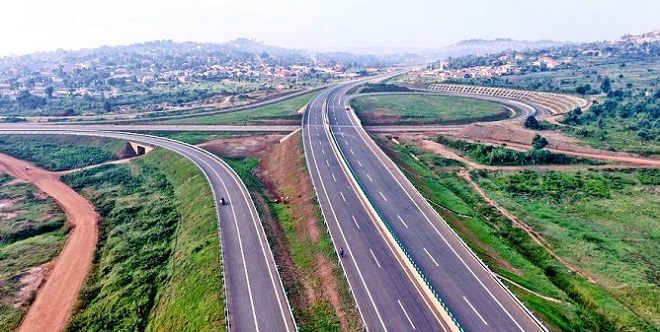The Kampala–Entebbe Expressway.
How government’s borrowing spree is leaving citizens bearing the cost
Kampala, Uganda | Julius Businge | At dawn, the roar of engines rises above the quiet streets of Entebbe as David Tumusiime, 47, prepares for his daily commute to Kampala. Like thousands of other motorists, he joins the line snaking toward the Entebbe Expressway, a sleek road built to cut travel time—but one that carries an invisible weight.
Every day, Tumusiime parts with Shs10,000 in toll fees, a small fortune for a mid-level employee supporting a family of five. “It’s convenient, but the cost adds up quickly because of government debt repayments,” he says, his voice tinged with resignation. “If I saved that 10,000 each day, I could buy two kilos of sugar for my family. Those who can’t afford the tolls are forced to use longer, rougher roads that waste fuel and time.”
The Kampala–Entebbe Expressway, financed through a $476 million (approximately Shs1.785 trillion) loan from China Exim Bank, stands as a symbol of ambition—and consequence. Under the financing agreement, the Uganda National Roads Authority (UNRA) will collect tolls for 18 years to repay the loan, with Egis Road Operation contracted to handle day-to-day operations.
As of December 2023, toll revenues had reached Shs75 billion. Every shilling, according to the agreement, goes directly toward repaying the debt. For Tumusiime, who dreams of retiring at 55, that 18-year horizon feels like a sentence his children will serve. “Even when I stop working, the road will still be paying off the loan,” he says quietly. “Maybe my children will still be paying for it too.”
Borrowing in the people’s name
On October 20, 2025, Uganda’s Parliament embarked on the process to approve new loans worth Shs8.3 trillion—touted as funding for roads, energy, and infrastructure projects. Yet for many Ugandans, such approvals evoke as much anxiety as hope.
In the parliamentary chambers, where votes are cast and motions carried, few decisions resonate as deeply through the lives of ordinary citizens. Every loan approved in the air- conditioned hallways of Parliament echoes in the markets, on the farms, and in the small shops where prices creep upward and livelihoods tighten.
Finance Minister Henry Musasizi tabled the new borrowing proposal, seeking funds from lenders including the World Bank and Standard Chartered Bank. He argued that the loans were necessary to sustain key projects and drive economic recovery.
But the presentation was met with tension. Joel Ssenyonyi, the Leader of the Opposition, rose on a procedural point, revealing that he had learned some of the loans had already been signed off by authorities, effectively bypassing parliamentary scrutiny. “If these agreements were signed before Parliament approved them, then we are rubber-stamping decisions already made,” Ssenyonyi cautioned. “This undermines the integrity of this House and the people we represent.”
Speaker Thomas Tayebwa, visibly caught off guard, defended the process. “I am not aware of any prior signings,” he said. “As Speaker, my duty is to forward loan requests to the relevant committees for proper examination.” The exchange left the chamber divided. Opposition MPs warned of eroding accountability, while government MPs insisted that existing mechanisms ensured transparency. Yet outside the chamber, in places like Entebbe and Kikuubo, the debate felt far removed from reality. For citizens like Tumusiime, what mattered was not the procedural wrangling—but the price tag attached to it.
The weight of the ledger
According to the latest Annual Debt Statistical Bulletin (June 2025), Uganda’s total public debt had reached Shs116.2 trillion (US$32.3 billion), approximately 51.3% of GDP. That represents a 26.2% increase from the previous year’s Shs89.5 trillion. Domestic borrowing alone soared by nearly 49% in one year—from Shs40.6 trillion to Shs60.3 trillion—while external debt climbed to Shs55.9 trillion. Much of this domestic borrowing carries higher interest rates, straining national resources and crowding out the private sector.
On October 21, Ramathan Ggoobi, the Permanent Secretary and Secretary to the Treasury, defended the borrowing strategy. He announced that Uganda would receive over $2 billion (Shs7.5 trillion) in concessional financing from the World Bank over the next three years, marking the resumption of support suspended after the enactment of anti-LGBTQ legislation.
“This funding will revitalize key projects in energy, transport, agriculture, and ICT,” Ggoobi said, describing the loans as “a necessary lifeline” for the economy. Yet for many economists, these “lifelines” have become a financial noose—tightening with every new agreement.
The hidden tax on daily life
In the bustling trading hub of Kikuubo, Sarah Nabukenya, a mother of three, arranges sacks of sugar and flour in her stall. “Every year, prices of sugar, salt, and food go up,” she says.
“Transport costs increase, taxes increase. It’s all connected.” For Nabukenya, the link between Parliament’s borrowing decisions and her shrinking profits is direct but invisible. “We don’t see the loans they talk about in our lives,” she adds. “We only feel them when everything becomes more expensive,” she tells The Independent.
Bank of Uganda data shows that commercial lending rates have hovered between 20% and 22% over the past five years. For small traders like John Mukasa of Busega Township, this is crippling. “Every time I approach the bank, they tell me rates have gone up,” he says.
“Government borrows heavily, and we pay the price.” Mukasa explains that in 2024, his operational costs rose by as much as 12%, squeezing profits and forcing him to lay off casual workers. “I can’t expand, I can’t restock. It’s like we are stuck,” he tells The Independent.
In Kibaale District, the effects reach the farms. “Loans are expensive, and farmers cannot afford seeds or fertilizer,” says maize farmer Taddewo Bwambale. A district official confirms to The Independent that only 20–25% of smallholder farmers access formal credit due to high interest rates.
“Debt in the economy hits us first,” Bwambale says. “We cannot grow what we used to because government no longer supports us like before.”
In Kagadi, the district forestry officer, Patrick Abigaba, paints an equally grim picture. “Our department has a Shs50 million annual budget, but we receive only about 20% of it,” he tells The Independent in an interview. “It affects everything—tree planting, monitoring, and community education. We are left planning on paper.”
What parliament debates—and what the people feel
Inside Parliament, the numbers sound abstract. But outside, they manifest in potholes, crowded hospitals, and empty classroom shelves.
Manjiya County MP John Baptist Nambeshe has repeatedly warned that Uganda’s borrowing trajectory is unsustainable. “We cannot keep borrowing money we can’t repay,” he says. “Many projects remain incomplete or mismanaged, yet new loans keep coming.” Butambala County MP Muwanga Kivumbi adds that Parliament must demand accountability. “Every loan should be tied to a clear, revenue-generating project. Otherwise, we are merely mortgaging our children’s future.”
The Karuma and Isimba dam. Most of Uganda’s debt is consumed by these big infrastructure projects
Tororo District Woman MP Sarah Opendi echoes that sentiment: “Transparency is key. We should only borrow for projects that can pay for themselves,” she said in a separate interview. “Otherwise, we’re piling debt that the next generation will pay through higher taxes and fewer services.”
The ripple effects of this fiscal squeeze are visible in education and health. A Kibaale district official tells this publication on condition of anonymity that roughly half of government-aided schools have damaged classrooms and limited facilities, with a student-to-textbook ratio of about 1:20. “We cannot buy enough textbooks or repair classrooms,” the official says. “Students suffer because government gives us less money each year.”
When debt servicing consumes nearly 40% of domestic revenue, it is sectors like these that bear the brunt.
Debt and politics
Economists argue that Uganda’s rising debt is as much political as it is economic. “Many investors view treasury bills and bonds as risk-free, and that helps government raise funds,” says John Walugembe, head of the Federation of Small and Medium-Sized Enterprises. “But it also means government competes directly with the private sector for credit, driving up interest rates,” he says in an interview with this reporter.
Senior economist Fred Muhumuza is blunter. “Public investment is being driven by political expediency rather than economic necessity,” he says. “Projects are launched to win political favor, not to meet urgent development needs. That’s how we end up with expensive highways and half-finished industrial parks.” He warns that Uganda is “in a debt trap,” with a growing share of revenue diverted to debt repayment. “We’re paying for past mistakes instead of investing in future potential,” he says. “That’s the definition of unsustainable.”
Enock Twinoburyo, a senior economist and advisor to regional governments, stresses the importance of disciplined borrowing. “Uganda’s debt levels may appear moderate, but without strict fiscal discipline, the risks become overwhelming,” he says. “Borrowing is not inherently bad, but it must be strategic, transparent, and productive.”
Civil society voices are equally concerned. Julius Mukunda, executive director of the Civil Society Budget Advocacy Group, says while government securities remain a stable investment, their expansion limits funds available for social services. “Yes, investors see treasury bills and bonds as safe,” he says, “but safety for investors often means scarcity for citizens,” he told The Independent.
World Bank warns
The World Bank’s 25th Uganda Economic Update, published September 30, reinforces these fears. It shows that Uganda’s public debt now stands at nearly 53% of GDP—approaching dangerous levels.
“Increased spending in this election cycle, and with debt-to-GDP reaching almost 53%, raises uncertainties,” said World Bank Country Manager Francisca Ayodeji Akala. Ayodeji urged authorities to “minimize unplanned expenditures and increase effectiveness in generating domestic revenues rather than cutting development spending.”
Silver Namunane, a World Bank tax economist, pointed out that Uganda’s tax-to-GDP ratio remains just 14%, below the Sub-Saharan average and short of the critical 15% needed for sustainable growth.
“Uganda’s tax system continues to struggle with low revenue yield,” he said. The report calls for reforms to broaden the tax base, reduce tax exemptions, and make the system more equitable. Without such reforms, Uganda’s dream of middle-income status risks being “mortgaged to its swelling debt.”
The people behind the numbers
In many ways, Uganda’s debt story is the story of its people—those who bear the unseen costs of decisions made in their name. For a teacher in Kiryandongo waiting for a salary, for a trader in Kikuubo watching transport costs rise, for a farmer in Kibaale unable to buy fertilizer, debt is not a statistic—it’s an everyday constraint.
When Parliament debates billions in loans, few imagine the small shifts it causes in a family’s dinner table conversation: less sugar, fewer textbooks, another deferred hospital visit. Uganda’s growing debt has become an invisible tax—paid not just in shillings, but in opportunities lost.
Back to the road
As dusk falls on Entebbe, David Tumusiime drives home along the toll road he helped pay for—and continues to pay for every single day. The setting sun glints off the sign reading “Thank you for using the Entebbe Expressway.” He shakes his head and laughs quietly. “We are all paying,” he says. “Even those who don’t use the road pay for it somehow. Maybe one day Parliament will think about us before signing the next loan.”
His headlights cut through the evening haze as he joins other cars heading toward Entebbe’s outskirts—each driver unknowingly carrying a share of the national debt, each kilometer traveled a reminder of how deeply public debt is woven into private lives.
And as Uganda’s lawmakers prepare for another round of debates over new loans and new promises, the question that echoes from Entebbe to the corridors of Parliament remains the same: In whose name—and at what cost—are these debts being taken?





